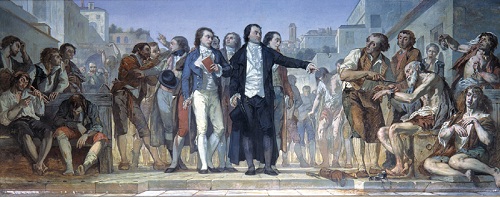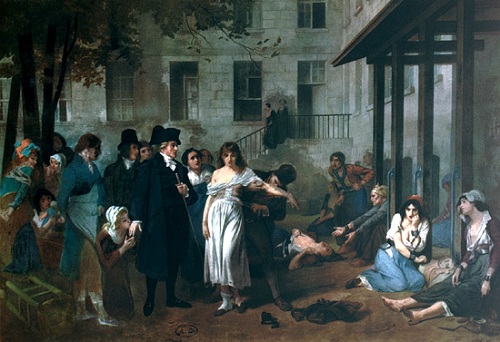
Image Credit: Archives of General Pyschiatry
When historians seek gathering metaphors to describe the French Revolution--with its violent upheavals, experiments in re-arranging calendar time, and, of course, the demands for liberty and equality that underwrote these events--they rarely describe the atmosphere or environment of the period as particularly stable or "sane." And yet the work of Philippe Pinel--a progressive French physician who helped lay the groundwork for a major shift in mental health treatment--has been nonetheless remembered as a figurative crystallization of the Revolution's lofty, humanist goals--goals which in turn influenced the trajectory of ninenteenth century psychiatry. Today, I seek to briefly explore how 19th century visual re-enactments of Pinel's participation in a highly mythicized (and mostly apocryphyl) event--a ritualized "unchaining" of the captive patients-- were used to remind French citizens of the virtues of republican government during times of national upheaval.

Image Credit: Wikipedia
Towards the end of the eighteenth century, a growing number of European physicians began to doubt the efficacy and morality of then-dominant methods of incarcerating the mentally ill--namely, the extensive use of chains and physical punishments to keep patients subdued, and, more generally, an emphasis upon containment rather than treatment. Additionally, on an institutional level, the asylums of France were objects of much suspicion; in the ancien regime, after all, any citizen might be one lettre de cachet away from imprisonment. In this environment, Pinel, along with several other French asylum directors, began a policy which tended to remove chains from non-violent prisoners and begin a new form of therapy called "moral treatment" in the second half of the 1790's. Though space limitations prohibit me from going into too much detail here, it should be mentioned that the "moral" treatment was based on a belief that madness--previously regarded as a totalizing condition that justified perpetual separation from society--was frequently only an imbalance in the mind that could could be realigned by various forms of therapy. As the years wore on and the lore surrounding Pinel grew, he frequently was portrayed as a single-handed avatar of benificent Revolutionary Republicanism.
Charles Louise-Muller's commemoration of the event,"Pinel Orders the Chains Removed From the Insane at Bicêtre" (pictured at the top of this blog post) was completed in 1849--near the dawn and collapse of the short-lived Second French Republic. As we can quickly notice, Pinel, who by most accounts, wasn't present when this kind of chain-removal took place, takes on a heroic pose here, dominating the center of the action amidst a band of lightness which separates him from the leagues of drab, darkened clusters of patients that line the sides of the image--almost as if he is parting a sea of madness. At the same time, the dominant colors of the image befit the flag of the Revolution: red, white, and blue. While several of the patients look at their newly free hands in shock, we also notice them looking to their savior--watching what he will do next. Largely docile, the patients accept the enlightened physician's gift of freedom and his authority.

Image Credit: Archives of General Psychiatry
Our next image is Tony Robert-Fleury's "Pinel Délivrant les aliénées," or "Pinel Delivering the insane." Painted in 1878--three year's into the third French republic--the image likewise returns to the liberatory power of the physician and the patients' debt to their liberator. In this case, however, the scene is the women's hospital of Salpêtrière, and Pinel is off-center, advising the manumission of a young, scantily clad, woman in white. As with the previous picture, we see a docile group of unfettered patients on the left hand side of the image looking calmly at the scene, and one of the women is actually kissing Pinel's hand while he stoically does his business. The women on the right, prostrate and languid, await their hoped-for freedom. Far in the background, meanwhile, we see two women moving as they please.
But ultimately, the woman in the center commands the most attention in this image, for she is both visually striking and the center of Pinel's attention as well. Susan A. Hawes of Antioch College argues that the female patient who takes center stage "assumes a position which suggests her unreason, her vulnerability to patrirarchal reason, and the taming of her dangerous sexuality." While the link portrayed here between sexual wantonness and madness is by no means a new one, Hawes points out that it became increasingly important "in this context of morally righteous 'humane' treatments." In this way, then, these images, which were likely comissioned to reinscribe revolutionary era values into France's later republican contexts, bear out Michel Foucault's claim that we should see Pinel's work as emblematic of a general shift in discipline and governmentality toward more discretely professsionalized forms.



Recent comments
2 years 29 weeks ago
2 years 44 weeks ago
2 years 44 weeks ago
2 years 50 weeks ago
3 years 4 weeks ago
3 years 4 weeks ago
3 years 4 weeks ago
3 years 6 weeks ago
3 years 6 weeks ago
3 years 6 weeks ago